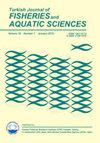Comparative Toxicity Analysis of Fenpropathrin with Its Two Commercial Formulations on Developing Zebrafish Embryos
IF 1.7
4区 农林科学
Q3 FISHERIES
引用次数: 0
Abstract
Fenpropathrin displays enduring effects on aquatic environment which can be highly toxic and accumulative to non-targeted aquatic organisms like fish. While most of the previous studies focused on the toxicity of analytical grade of Fenpropathrin, insufficient attention has been paid to compare toxicity of the active ingredient (a.i) with its commercial formulation. Therefore, the present study is an attempt to evaluate the lethal as well as sublethal toxicity along with cardiac, morphological, behavioral and neurotoxic biomarker responses induced by Fenpropathrin and its commercial formulation Meothrin and Danitol on zebrafish embryos. The study reveals 96-hour (h) LC50 values that are 0.156(0.121-0.202), 0.953(0.736-1.248) and 1.168(0.913- 1.503) mg a.i/L; 96 h EC50 values are 0.016, 0.152 and 0.369 mg a.i/L and Teratogenic Index (TI) ratio of 9.75, 6.26 and 3.16 for Fenpropathrin, Meothrin and Danitol respectively (Fenpropathrin>Meothrin>Danitol). The reduction in toxicity in commercial formulations may be attributed to Control Release Systems (CRS). The study also reveals that intensity of malformations, teratogenic potential, behavioral abnormality, cardiotoxicity and neurotoxicity are more prominent in Fenpropathrin when compared to its two formulations.甲氰菊酯与两种市售配方对斑马鱼胚胎发育的毒性比较分析
甲氰菊酯对水生环境具有持久的影响,对鱼类等非靶向水生生物具有剧毒和蓄积性。虽然以前的大多数研究都集中在分析级甲氰菊酯的毒性上,但对活性成分(a.i)与其商业制剂的毒性比较关注不足。因此,本研究试图评估甲氰菊酯及其商业制剂Meothrin和Danitol对斑马鱼胚胎的致死性和亚致死性毒性,以及心脏、形态、行为和神经毒性生物标志物反应。研究表明,96小时(h)LC50值分别为0.156(0.121-0.202)、0.953(0.736-1.248)和1.168(0.913-1.503)mg a.i/L;96 h EC50值分别为0.016、0.152和0.369 mg a.i/L,氟丙菊酯、甲氧麻黄酮和丹妮醇的致畸指数(TI)比分别为9.75、6.26和3.16(氟丙菊酯>甲氧麻酚>丹妮醇)。商业制剂毒性的降低可归因于控制释放系统(CRS)。研究还表明,与两种制剂相比,甲氰菊酯的畸形强度、致畸潜力、行为异常、心脏毒性和神经毒性更为突出。
本文章由计算机程序翻译,如有差异,请以英文原文为准。
求助全文
约1分钟内获得全文
求助全文
来源期刊

Turkish Journal of Fisheries and Aquatic Sciences
FISHERIES-MARINE & FRESHWATER BIOLOGY
CiteScore
3.10
自引率
0.00%
发文量
43
审稿时长
3 months
期刊介绍:
Turkish Journal of Fisheries and Aquatic Sciences" (TrJFAS) is a refereed academic journal has been published by Central Fisheries Research Institute of Turkey and Japan International Cooperation Agency (JICA), and published in English.
It aims to address research and needs of all working and studying within the many varied areas of fisheries and aquatic sciences.
The Journal publishes English language original research papers, critical review articles, short communications and technical notes on applied or scientific research relevant to freshwater, brackish and marine environments.
TrJFAS was published biannually (April & November) between 2001 and 2009. A great number of manuscripts have been submitted to the journal for review from acceptance of the SCI index. Thereby, the journal has been published quarterly (March, June, September and December) from 2010 to 2017. The journal will be published monthly in 2018.
 求助内容:
求助内容: 应助结果提醒方式:
应助结果提醒方式:


